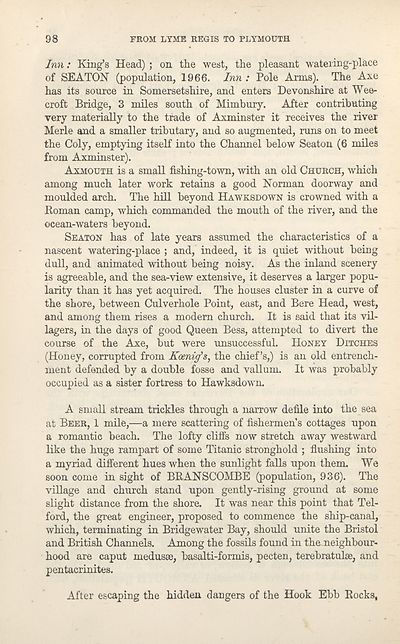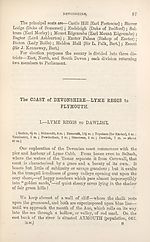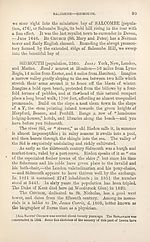Download files
Complete book:
Individual page:
Thumbnail gallery: Grid view | List view

FROM LYME REGIS TO PLYMOUTH
Inn: King’s Head) ; on the west, the pleasant watering-place
of SEATON (population, 1966. Inn : Pole Arms). The Axe
has its source in Somersetshire, and enters Devonshire at Wee-
croft Bridge, 3 miles south of Mimbury. After contributing
very materially to the trade of Axminster it receives the river
Merle and a smaller tributary, and so augmented, runs on to meet
the Coly, emptying itself into the Channel below Seaton (6 miles
from Axminster).
Axmouth is a small fishing-town, with an old Church, which
among much later work retains a good Norman doorway and
moulded arch. The hill beyond Hawksdown is crowned with a
Boman camp, which commanded the mouth of the river, and the
ocean-waters beyond.
Seaton has of late years assumed the characteristics of a
nascent watering-place ; and, indeed, it is quiet without being
dull, and animated without being noisy. As the inland scenery
is agreeable, and the sea-view extensive, it deserves a larger popu¬
larity than it has yet acquired. The houses cluster in a curve of
the shore, between Culverhole Point, east, and Bere Head, west,
and among them rises a modern church. It is said that its vil¬
lagers, in the days of good Queen Bess, attempted to divert the
course of the Axe, but were unsuccessful. Honey Ditches
(Honey, corrupted from Kcenig's, the chief’s,) is an old entrench¬
ment defended by a double fosse and vallum. It was probably
occupied as a sister fortress to Hawksdown.
A small stream trickles through a narrow defile into the sea
at Beer, 1 mile,—a mere scattering of fishermen’s cottages upon
a romantic beach. The lofty cliffs now stretch away westward
like the huge rampart of some Titanic stronghold ; flushing into
a myriad different hues when the sunlight falls upon them. We
soon come in sight of BRANSCOMBE (population, 936). The
village and church stand upon gently-rising ground at some
slight distance from the shore. It was near this point that Tel¬
ford, the great engineer, proposed to commence the ship-canal,
which, terminating in Bridgewater Bay, should unite the Bristol
and British Channels. Among the fossils found in the neighbour¬
hood are caput medusae, basalti-formis, pecten, terebratulse, and
pentacrinites.
After escaping the hidden dangers of the Hook Ebb Rocks,
Inn: King’s Head) ; on the west, the pleasant watering-place
of SEATON (population, 1966. Inn : Pole Arms). The Axe
has its source in Somersetshire, and enters Devonshire at Wee-
croft Bridge, 3 miles south of Mimbury. After contributing
very materially to the trade of Axminster it receives the river
Merle and a smaller tributary, and so augmented, runs on to meet
the Coly, emptying itself into the Channel below Seaton (6 miles
from Axminster).
Axmouth is a small fishing-town, with an old Church, which
among much later work retains a good Norman doorway and
moulded arch. The hill beyond Hawksdown is crowned with a
Boman camp, which commanded the mouth of the river, and the
ocean-waters beyond.
Seaton has of late years assumed the characteristics of a
nascent watering-place ; and, indeed, it is quiet without being
dull, and animated without being noisy. As the inland scenery
is agreeable, and the sea-view extensive, it deserves a larger popu¬
larity than it has yet acquired. The houses cluster in a curve of
the shore, between Culverhole Point, east, and Bere Head, west,
and among them rises a modern church. It is said that its vil¬
lagers, in the days of good Queen Bess, attempted to divert the
course of the Axe, but were unsuccessful. Honey Ditches
(Honey, corrupted from Kcenig's, the chief’s,) is an old entrench¬
ment defended by a double fosse and vallum. It was probably
occupied as a sister fortress to Hawksdown.
A small stream trickles through a narrow defile into the sea
at Beer, 1 mile,—a mere scattering of fishermen’s cottages upon
a romantic beach. The lofty cliffs now stretch away westward
like the huge rampart of some Titanic stronghold ; flushing into
a myriad different hues when the sunlight falls upon them. We
soon come in sight of BRANSCOMBE (population, 936). The
village and church stand upon gently-rising ground at some
slight distance from the shore. It was near this point that Tel¬
ford, the great engineer, proposed to commence the ship-canal,
which, terminating in Bridgewater Bay, should unite the Bristol
and British Channels. Among the fossils found in the neighbour¬
hood are caput medusae, basalti-formis, pecten, terebratulse, and
pentacrinites.
After escaping the hidden dangers of the Hook Ebb Rocks,
Set display mode to:
![]() Universal Viewer |
Universal Viewer | ![]() Mirador |
Large image | Transcription
Mirador |
Large image | Transcription
| Antiquarian books of Scotland > Adventure and adventurers > Black's guide to the counties of Dorset, Devon, & Cornwall > (120) |
|---|
| Permanent URL | https://digital.nls.uk/142587818 |
|---|
| Description | Thousands of printed books from the Antiquarian Books of Scotland collection which dates from 1641 to the 1980s. The collection consists of 14,800 books which were published in Scotland or have a Scottish connection, e.g. through the author, printer or owner. Subjects covered include sport, education, diseases, adventure, occupations, Jacobites, politics and religion. Among the 29 languages represented are English, Gaelic, Italian, French, Russian and Swedish. |
|---|

